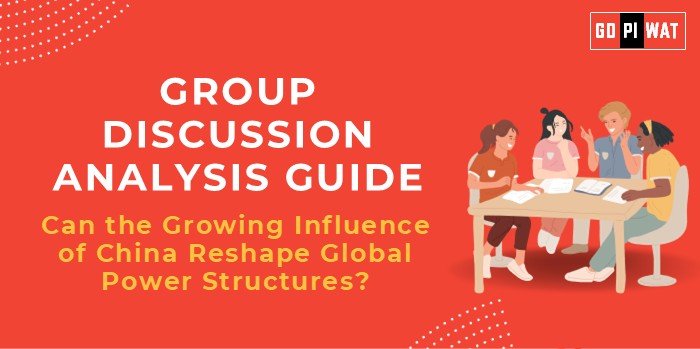📋 Group Discussion Analysis Guide: Can the Growing Influence of China Reshape Global Power Structures?
🌐 Introduction to the Topic
📖 Opening Context
The growing influence of China in global affairs has sparked significant debate regarding its potential to reshape established power structures, including the political, economic, and technological domains. As the world’s second-largest economy, China’s assertive diplomacy and global initiatives such as the Belt and Road Initiative (BRI) have redefined the traditional power balance.
📜 Topic Background
Since the late 20th century, China has transitioned from a closed, agrarian economy to a global superpower. Key milestones include its accession to the World Trade Organization (WTO) in 2001 and its ambitious technological goals under “Made in China 2025.” China’s actions in the South China Sea and its partnerships with nations across Africa, Latin America, and Asia illustrate its intent to expand influence.
📊 Quick Facts and Key Statistics
- 💰 GDP (2023): $19.4 trillion – The second-largest globally, showcasing China’s economic might.
- 🌍 Belt and Road Initiative (BRI): Over 140 countries involved – Demonstrates its growing soft power.
- 🛡️ Defense Spending (2023): $225 billion – Indicates strategic investments in military expansion.
- 📈 Global Trade: $6.3 trillion in 2022 – Reflects its centrality in global commerce.
🤝 Stakeholders and Their Roles
- 🏛️ Chinese Government: Orchestrates initiatives such as the BRI and aims for economic and military dominance.
- 🇺🇸 United States: Engages in strategic rivalry to counterbalance China’s influence in trade, technology, and geopolitics.
- 🌐 Developing Nations: Benefit from infrastructure investments but face debt dependency challenges.
- 🏢 International Organizations: Entities like the UN and WTO are influenced by China’s growing clout.
🏆 Achievements and Challenges
✨ Achievements
- 📊 Economic Growth: Sustained rapid GDP growth, making it a critical trade partner.
- 🤖 Technological Leadership: Investments in AI, 5G, and semiconductors, positioning it as a tech leader.
- 🌍 Global Partnerships: Expansion through BRI, promoting infrastructure development globally.
⚠️ Challenges
- 🌏 Geopolitical Tensions: Disputes over Taiwan, the South China Sea, and strained US-China relations.
- 💳 Debt Diplomacy Allegations: Concerns over BRI loans burdening developing countries.
- ⚖️ Global Trust Deficit: Issues surrounding human rights and lack of transparency.
🌍 Global Comparisons
- 🇺🇸 United States: Maintains strategic alliances (e.g., NATO) and technological innovation leadership.
- 🇪🇺 European Union: Faces challenges in balancing economic ties with China and maintaining a united stance.
📖 Case Study
- 🌍 BRI in Pakistan: Infrastructure development has boosted trade but raised concerns over debt sustainability.
💡 Structured Arguments for Discussion
- 🛠️ Supporting Stance: “China’s rise as a global power exemplifies how economic growth and strategic diplomacy can challenge traditional power structures, paving the way for a multipolar world.”
- 🛡️ Opposing Stance: “China’s global ambitions, while impressive, are fraught with concerns over economic coercion and geopolitical instability, potentially undermining long-term global cooperation.”
- ⚖️ Balanced Perspective: “While China’s influence is reshaping global structures, its success depends on addressing global trust issues and fostering sustainable partnerships.”
🎯 Effective Discussion Approaches
🔑 Opening Approaches
- 📊 Highlight BRI’s transformative potential using key statistics.
- 📖 Begin with a contrast between China’s rise and historical US dominance.
⚙️ Counter-Argument Handling
- 🔄 “While China’s growth is unparalleled, addressing concerns of debt traps and transparency can ensure its influence is seen as constructive rather than coercive.”
🧠 Strategic Analysis of Strengths and Weaknesses
SWOT Analysis:
- 💪 Strengths: Rapid economic growth, technological advancements, global partnerships.
- 🛠️ Weaknesses: Trust deficit, geopolitical tensions, debt diplomacy concerns.
- 🌟 Opportunities: Global leadership, innovation in green energy, expanding markets.
- ⚠️ Threats: Resistance from Western powers, internal economic challenges, demographic shifts.
🏫 Connecting with B-School Applications
📚 Real-World Applications
- 🌍 Business strategies to navigate trade wars or collaborate in BRI-related projects.
🎓 Sample Interview Questions
- ❓ “How can businesses mitigate risks in China-led initiatives like BRI?”
- ❓ “Evaluate the implications of China’s technological growth for global competition.”
💡 Insights for B-School Students
- 📈 Understand multipolar trade dynamics.
- ⚖️ Analyze risk-reward scenarios in global partnerships.


